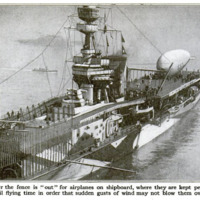The fences built on the upper decks of aircraft carriers in order to protect airplanes from sudden gusts of wind
Contenuto
-
Titolo
-
The fences built on the upper decks of aircraft carriers in order to protect airplanes from sudden gusts of wind
-
Article Title and/or Image Caption
-
Fencing in the Flighty Airplane
-
extracted text
-
AIRPLANES were never meant to
go to sea. When the war forced
them to join the navy they found
themselves cramped for starting and
landing room. Then ships especially
designed to mother airplanes helped
to solve the problem by providing un-
usually long and wide flush decks as
marine aviation fields.
H. M. S. Furious, shown in the
picture above, is a combined hangar
and flying-field. One of the most
curious bits of her special equipment
is the high fence built around her
upper deck forward of her lone mast.
It is intended to keep the ship's flock
of airplanes from wandering unbidden
from the home pasture. It is not
easy to get an airplane
into the air from the
deck, but it's easy
enough for a gust of
wind to slip under the
wings of one idling
on deck and urge the
airplane overboard.
The fence can be
raised and lowered.
-
Lingua
-
eng
-
Data di rilascio
-
1919-08
-
pagine
-
76
-
Diritti
-
Public domain (Google digitized)
-
Archived by
-
Davide Donà
-
Alberto Bordignon (Supervisor)
 1.png
1.png